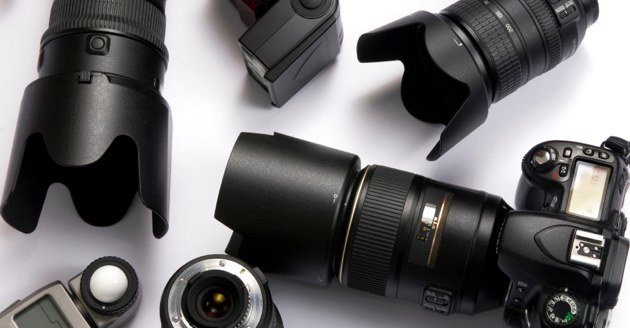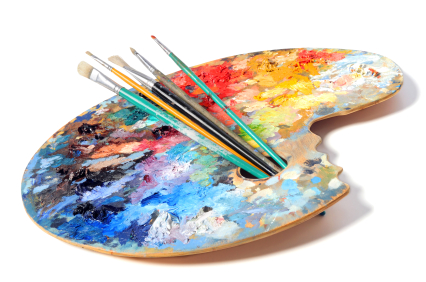Art News and Updates from Gallereo
All the latest news from the art world, as well as what's happening here at Gallereo. If you've built a gallery at Gallereo, let us know about your experience and you and your site could feature in our blog in the coming weeks.
Saturday 12th October 2013SEO Basics for Artists

Most of you have probably heard the acronym 'SEO' by now - but for those of you who haven't, it stands for 'search engine optimisation' and it's one of the most important aspects of online art sales. Search engines are responsible for a massive percentage of traffic for almost every website, and your Gallereo page is no exception. Unfortunately, many artists are not exactly sure how to take advantage of SEO techniques when it comes to their art sales, so we'll take you through some basic tips you can apply to boost your web presence. Even though the field of SEO is huge and constantly changing, these tips are fairly universal and not likely to change any time in the future.
The most important thing you need to realize is that text is the key to all good SEO. While it might seem obvious, it's crucial to remember that because all web searches are conducted via text, the more text you have associated with your images and your Gallereo page, the more often you'll appear in search results. Manipulating where your rankings appear is also important, but a bit outside the scope of this article - and we're focused on the basics here. This focus on the importance of text presents a few different opportunities.
First of all, be very careful how you title your work. If you name your artwork 'Untitled' and leave it at that, it's highly unlikely that anyone is going to find it. While I wouldn't presume to ask you to change the real title (or lack of title), for the purposes of your Gallereo page it's very helpful to add a brief bit of descriptive text after the actual title. Consider mentioning the subject matter, the medium you used, and perhaps even the general colour palette you worked with.
Next, ensure that you've filled out the description section fully. There's no need to include an entire essay on the piece, but be sure to discuss the elements you mentioned in your brief title description in longer detail. Include as much information as you can to help potential art buyers find your work, and include mentions of some popular search terms as well, such as 'contemporary art for sale' and so on - just be sure to integrate them naturally into sentences, as Google will penalise sites that it thinks are simply 'keyword stuffing' (ie: filling the entire page with search keywords and no real content).
Finally, and we mentioned this in our previous post, make good use of your Gallereo blog. It's a part of your subscription, and an incredibly valuable tool if you take the time to use it well. When you integrate it with your Facebook fan page, as every time someone shares it or 'Likes' it on Facebook, Google (and other search engines) will regard it even more highly.
Most of you have probably heard the acronym 'SEO' by now - but for those of you who haven't, it stands for 'search engine optimisation' and it's one of the most important aspects of online art sales. Search engines are responsible for a massive percentage of traffic for almost every website, and your Gallereo page is no exception. Unfortunately, many artists are not exactly sure how to take advantage of SEO techniques when it comes to their art sales, so we'll take you through some basic tips you can apply to boost your web presence. Even though the field of SEO is huge and constantly changing, these tips are fairly universal and not likely to change any time in the future.
The most important thing you need to realize is that text is the key to all good SEO. While it might seem obvious, it's crucial to remember that because all web searches are conducted via text, the more text you have associated with your images and your Gallereo page, the more often you'll appear in search results. Manipulating where your rankings appear is also important, but a bit outside the scope of this article - and we're focused on the basics here. This focus on the importance of text presents a few different opportunities.
First of all, be very careful how you title your work. If you name your artwork 'Untitled' and leave it at that, it's highly unlikely that anyone is going to find it. While I wouldn't presume to ask you to change the real title (or lack of title), for the purposes of your Gallereo page it's very helpful to add a brief bit of descriptive text after the actual title. Consider mentioning the subject matter, the medium you used, and perhaps even the general colour palette you worked with.
Next, ensure that you've filled out the description section fully. There's no need to include an entire essay on the piece, but be sure to discuss the elements you mentioned in your brief title description in longer detail. Include as much information as you can to help potential art buyers find your work, and include mentions of some popular search terms as well, such as 'contemporary art for sale' and so on - just be sure to integrate them naturally into sentences, as Google will penalise sites that it thinks are simply 'keyword stuffing' (ie: filling the entire page with search keywords and no real content).
Finally, and we mentioned this in our previous post, make good use of your Gallereo blog. It's a part of your subscription, and an incredibly valuable tool if you take the time to use it well. When you integrate it with your Facebook fan page, as every time someone shares it or 'Likes' it on Facebook, Google (and other search engines) will regard it even more highly.
Posted on October 12th 2013 on 05:39pm
0 Comments
Friday 11th October 2013Driving Traffic to Your Gallereo Page

Once you've carefully added all your beautiful artwork to your Gallereo page, it's important to start thinking of how to create exposure for yourself and bring in potential art buyers. We've discussed the power of social media as a means of getting noticed, but the more you reach out to people, the more successful you'll be - so let's take a look at how you can use your personal Gallereo blog in combination with your Facebook fan page to really get noticed.
As you may know, the more text you have associated with your name in search engines, the more easy it will be for people to find you, and making regular blog posts will dramatically increase your profile. If you take the concepts we put forwards in our post on Facebook fan pages and instead apply them directly to your blog, and then share your blog posts on your fan page, you'll be exponentially increasing the number of people who visit your Gallereo page. This can't be stressed enough - this way, when you post about something interesting or clever that you found online, people will be visiting your Gallereo blog page instead of some other external site. Obviously, you'll want to still link to that external site from your blog post, but they'll be visiting your blog first, and if you choose interesting enough content, they'll want to come back.
When you're sharing your blog posts on Facebook, there are a few things to take into consideration that can really improve fan engagement. When you paste a link into Facebook for sharing, it automatically visits the link and chooses a picture, a title and a short description to fill your post - but needless to say, the computer doesn't always choose the best options. Take a look through the various images they offer you, and pick the one that is most exciting and relevant. Take a moment to adjust the title and description as well, as Facebook obviously doesn't have the ability to summarise content or edit for clarity.
Another important thing to do is to actively ask your Facebook fans for feedback in your posts. While it might seem like a simple change, the most effective Facebook posts are those which ask the user to participate in discussions; it makes the user feel like they are personally involved in a dialog the two of you are creating, instead of simply reading a news article. Do your best to respond to any comments or questions your users offer, as the more engaged you are, the more engaged they will be. You wouldn't ignore comments made at a gallery opening, and this is no different! Make note of their questions as potential blog posts, although try not to single anyone out in your posts, and your fans will start to feel as though they're developing a strong relationship with you - and strong relations build strong sales.
Posted on October 11th 2013 on 04:49pm
0 Comments
Thursday 03rd October 2013How to Create a Simple Lightbox to Photograph Your Sculptures
 For those of you who work mostly in 2D media, getting your artwork online for your Gallereo page is relatively easy. But for artists who work in sculpture, jewelry or any other three-dimensional media, there are some more unique challenges. Obviously, you'll need a decent camera to create good quality images, but there are a few little tips and tricks that can take your decent sales images to a whole new level. One of the easiest ways to create a real WOW! reaction is to build a simple lightbox.
For those of you who work mostly in 2D media, getting your artwork online for your Gallereo page is relatively easy. But for artists who work in sculpture, jewelry or any other three-dimensional media, there are some more unique challenges. Obviously, you'll need a decent camera to create good quality images, but there are a few little tips and tricks that can take your decent sales images to a whole new level. One of the easiest ways to create a real WOW! reaction is to build a simple lightbox.
What's a lightbox, you ask? Often when you see product or sculptural photography, it's highlighted against a white background for impact - but instead of spending hours of your time in Photoshop removing backgrounds and faking realistic shadows, a lightbox will enable you to create that effect almost instantly. Best of all, you can make one from materials you've probably got lying around at home or the studio.
What you'll need:
-
A cardboard box (choose one large enough to fit your sculpture with as much extra room as possible - if your piece barely fits, you need a bigger box)
-
Tracing paper (wax paper will do in a pinch)
-
Bright white banner paper
-
Tape
-
X-acto knife or similar
-
A powerful light source (the Sun is excellent!)
First, decide the optimal orientation for your lightbox - this will depend on the shape of your pieces. Remove any open flaps from the box, and set it on one end with the open side face towards you. Using your knife, carefully cut 'windows' into the top, left and right sides. Remove as much of these sides as possible, but try to leave about 3-4 cm of 'frame' around the windows, to maintain the shape of the box.
Next, cover the windows you've just created with your tracing/wax paper and attach them with tape to the frames. This will allow a maximum amount of light to hit your subject, while diffusing it gently to create beautiful, soft shadows.
Finally, take your banner paper and attach it to the back of your lightbox, as close to the rear upper seam as possible. Let it hang down loosely in a gentle curve, so that it reaches the bottom of your lightbox and extends out the front. This is your backdrop, and of course you can use any colour of paper you wish, but in most cases white is the best choice.
That's all there is to it! Now take your lightbox, your piece and your camera outside, and find the best possible angle of lighting. If it's not a sunny day, indoor studio lights will work, but non-photographers often don't have access to a light bright enough to really create the stunning exposures that will create the best sales images. Don't forget to take some additional closeups to show the details of your piece. Once you've taken your shots, all that's left is a few simple contrast adjustments in Photoshop and you've got world-class sales photographs for your Gallereo page!
Posted on October 03rd 2013 on 04:18pm
0 Comments
Tuesday 01st October 2013The Importance of Optimism for Freelance Artists
 One of the things that makes artists successful is the emotional range they show in their work. The dynamics between positive and negative aren't just visual tools, they're emotional realities that are present in the greatest masterpieces - but there are times when even the best of us start to feel like we're trapped on the negative side of things. If your sales aren't taking off as much as you'd hoped, or you're feeling a huge creative block, it can be easy to start feeling overwhelmed by reality - which is exactly when you need to focus on remaining optimistic the most.
One of the things that makes artists successful is the emotional range they show in their work. The dynamics between positive and negative aren't just visual tools, they're emotional realities that are present in the greatest masterpieces - but there are times when even the best of us start to feel like we're trapped on the negative side of things. If your sales aren't taking off as much as you'd hoped, or you're feeling a huge creative block, it can be easy to start feeling overwhelmed by reality - which is exactly when you need to focus on remaining optimistic the most.
As a freelance artist, you're the one ultimately in charge of your own success. You don't have to answer to any bureaucratic hierarchy, but you also don't have as much of a safety net. This makes it crucial for you to be the one to constantly drive yourself forwards, and this ultimately becomes the difference between success and failure. If you get too focused on the negative, it can become all to easy to quit and try something else - but if you do, you'll never know the heights of success you can reach if you stay optimistic and keep trying.
There are a few great traits that all optimists share that can be vital to your success. The ability to learn from failure is one of the most useful traits they share, as it helps you counteract the negativity associated with failure by drawing something positive out of the experience. Don't see failures as failures, see them as experiments that taught you something about how you work and what you can do differently in the future. Once you start down the road to optimism, it becomes easier and easier - after all, happiness is the easiest thing in the world to share. A better attitude means clients and patrons will be more drawn to you, which only further reinforces your desire for an even better outlook on life. Best of all, optimism and happiness are often the best ways to spark your creativity and get working on the next great masterpiece.
If you're in a bit of a funk right now, there are several simple techniques you can use to start turning things around. First of all, surround yourself with people who in a better headspace than you are. As we mentioned earlier, happiness spreads easily, and if you spend time around people who are in a good creative place, they're likely to inspire you to do the same. Celebrate the achievement of small goals along your road to optimism, and you'll suddenly find yourself accomplishing larger and larger goals, whether it's finishing off that piece that's been languishing on your easel for weeks, or starting a brand new masterpiece. Finally, remember to keep things in perspective. When you're creatively blocked, things can seem a bit overwhelming, but the world doesn't solely exist in this one day: look forwards to your new creative horizons, and do what you can to move towards them.
Posted on October 01st 2013 on 04:47pm
0 Comments
Friday 27th September 2013How to Digitise Your Artwork
 Once you've decided to start selling your artwork online, it's important to make sure that the sales images you use on your Gallereo page show off your work properly. If you work in a digital medium, this is as simple as exporting some watermarked images from your favourite image editing program. If you work in a physical media, though, you'll need to find a good way to create digital images that show off your work to best effect. While it can take a bit of practice to get the hang of it, we've got some great tips to help make sure your images look as good as the reality.
Once you've decided to start selling your artwork online, it's important to make sure that the sales images you use on your Gallereo page show off your work properly. If you work in a digital medium, this is as simple as exporting some watermarked images from your favourite image editing program. If you work in a physical media, though, you'll need to find a good way to create digital images that show off your work to best effect. While it can take a bit of practice to get the hang of it, we've got some great tips to help make sure your images look as good as the reality.
First of all, it's important to consider how you're going to create your sales images. If you work in a medium such as watercolours, you may be able to get away with using a flatbed scanner to create your images, although this can become a bit problematic if you work format larger than the scanning bed. While it would be possible to stitch multiple scans together in Photoshop, this can be difficult for those not intimately familiar with digital image editing.
The most flexible option is to use a digital camera, but it comes along with its own set of challenges. If you're photographing a flat canvas, it's important to align the plane of your canvas with the image sensor of your camera to avoid the 'keystone effect' which can distort your images. This can be adjusted later in Photoshop, but the more accurate your initial photograph is, the less time you'll have to spend editing and the better your final result will be.. Alternatively, you could take several shots 'in situ', showing the piece standing on your easel or hung on a wall, and use that as your sales image along with several close-ups to show details. Personal preference comes into play here, but be sure to consider all the options to ensure you're showing your work in the best possible light.
If you're working in a 3D medium such as sculpture or installation-style art, take several different images and close-ups to get a sense of the piece as a whole. You may want to consider building a lightbox to create the 'professional product shot' style that you seen in most product shots, although again, an in situ style shoot may help your customers imagine the piece in their own home more easily.
Finally, the most critical element to your sales images is also the biggest headache - ensuring colour accuracy. Those of you who don't work digitally may not be aware, but colours are not always faithfully reproduced during the image-creation process from camera to website. The last thing you want is disappointed customers who bought your work expecting different colours, so it's worth the expense to buy a colorimeter. A colorimeter is a device containing a simple camera lens that attaches to your computer and your monitor. It comes with a program that displays various colours on your monitor screen, measures the output, and then adjusts your computer colour settings to make sure they are accurate. For the serious artist, they're an absolutely indispensable tool.
Posted on September 27th 2013 on 02:07pm
0 Comments
Tuesday 24th September 2013Using Social Networking to Drive Your Art Sales
 The power of social media is something that we've touched on briefly during our last few posts, but it's time to take a closer look at some of the ways it can benefit your art career the most. Having an active social media presence is no longer an option, either for successfully established artists or for newly-developing talents - but if you don't use it the right way, you may as well just be wasting your time.
The power of social media is something that we've touched on briefly during our last few posts, but it's time to take a closer look at some of the ways it can benefit your art career the most. Having an active social media presence is no longer an option, either for successfully established artists or for newly-developing talents - but if you don't use it the right way, you may as well just be wasting your time.
One of the most important aspects to your social media efforts is to carefully target who you interact with. Actively seek out groups and pages that are dedicated to critiques, art-sharing and art collecting. Start posting in these groups, and make your posts informative and helpful - that way, when the time comes for you to share your own newest work, people will recognise your name and already have accepted you into the community.
The other crucial element is to create a Facebook page dedicated to your own work. Think of it as an extension of your Gallereo page, one that allows you to quickly and easily get in touch with your fans, letting you inform them of new work that you've posted, any new shows that you've got upcoming, and any sort of sales or promotions you want to offer on your work. Gallereo integrates easily with your social media page, making it even easier for you to share updates with your fans. This is where the real benefits from social media begin to affect the number of pieces you sell.
To make your page truly effective, however, you need to develop a fan base that truly admires and appreciates your work. These people will become your own personal "artwork evangelists" - they will share your work with their friends, who will hopefully share it with their friends, etc until you become an Internet phenomenon. As Kevin Kelly puts it, they're going to become your '1000 true fans'. His hypothesis is that once your community of 'artwork evangelists' reaches the 1000 mark, you'll really start seeing the benefits that social media sharing can offer you, and your career will start taking off. He was referring to a brand, of course, but when you're an artist, you - and your signature style - become your brand. To make sure you keep your fanbase actively interested, be sure to post other interesting things above and beyond your own artwork. This will ensure that your fans regularly come back to your page, which will make them more ready to appreciate and share your artwork when you add it into the mixture of posts you make. Try to post at least once every day to your page, but don't overdo it - people will pull away if they feel they are getting 'spammed' with posts from your page.
Optionally, you can also sign up for a Twitter account, and link it to your Facebook account to increase your pool of potential viewers for each new piece of work you post. Now that Twitter has begun to incorporate image-based tweets, it's a much more viable tool for artists than it originally was. Regardless of this, though, Facebook is still the undisputed champion for artists when it comes to useful social media.
Posted on September 24th 2013 on 01:41pm
0 Comments
Friday 20th September 2013Top Tips for Selling Your Artwork Online
 Now that you've had a chance to go over our 'first steps' for artists working in the digital age, it's time to really dig down deep and highlight some of the best strategies you can use to make your artistic career a success. Once you've set up your Gallereo page, there are a number of things you can do to optimise it and ensure that your fans and potential customers can find your work. Let's look at some of the most helpful and effective tips!
Now that you've had a chance to go over our 'first steps' for artists working in the digital age, it's time to really dig down deep and highlight some of the best strategies you can use to make your artistic career a success. Once you've set up your Gallereo page, there are a number of things you can do to optimise it and ensure that your fans and potential customers can find your work. Let's look at some of the most helpful and effective tips!
One of the most important things - and one of the most regularly neglected things - that you can do is to ensure that your artwork is accompanied by good text descriptions. A good many art buyers will find your work through search engines like Google and Yahoo, so the more text you have on your pages, the more likely they are to find you. However, remember that it's important to use phrases and keywords in your descriptions that potential customers will actually be using in their search queries. Don't just talk about the intent behind the piece. Be descriptive about your general style, any famous artists who influenced the piece, and if it's a one-of-a-kind work, be sure to make it clear that the piece is still for sale. We'll go more in-depth into SEO for artists in another post, so be sure to stay tuned for that.
Social media is a buzzword that is thrown around a great deal these days, but with good reason: it really does work when it comes to promoting yourself and your work. We briefly discussed the value of social in our 'first steps' post, but it's important to take social media seriously. It gives you a way to keep your name and your work in the forefront of art buyers minds, and lets you instantly reach out to your fanbase when you've completed a new piece of work. Additionally, it allows you to get in touch with other artists, groups and collectives who can be extremely valuable assets when it comes to critiques, ideas and inspiration, not to mention group shows and other sales boosts. This is even more beneficial if you're not located in a big city with a thriving art scene, as you can reach out to other artists no matter where they are in the world.
Finally, it's important to remember that things might start off slower than you would hope. Selling artwork is never easy at the best of times, and it can take a while to gain popularity. While it's a great goal to have your work 'go viral' and become extremely widely shared and well-known, it can take time to accomplish this. It's important not to let the initial stages of selling online discourage you, as it can take sometimes take months to start seeing results from your self-promotion efforts. But if you stick with it, and follow our tips and tricks, you can almost be sure that you'll start gaining the reputation and sales that will make your art career a success.
Posted on September 20th 2013 on 03:36pm
0 Comments
Tuesday 17th September 2013The First Steps for Artists in the Digital Age As an artist, one of the most important things you can do once you’ve created your masterpiece is to get it into the public eye. While the traditional art gallery can be a useful tool if you're lucky enough to know the right people, the Internet has opened up huge new areas of opportunity for artists, no matter who you know or what media you work with. We’ll take you through some of the quick and easy ways you can start to promote your work online and start gaining the recognition – and sales – that you deserve.
As an artist, one of the most important things you can do once you’ve created your masterpiece is to get it into the public eye. While the traditional art gallery can be a useful tool if you're lucky enough to know the right people, the Internet has opened up huge new areas of opportunity for artists, no matter who you know or what media you work with. We’ll take you through some of the quick and easy ways you can start to promote your work online and start gaining the recognition – and sales – that you deserve.
First and foremost, the most important element is to start developing a presence on the web. Gallereo offers a simple way for artists to showcase their work online, without having to learn how to create websites. This allows you to point potential fans - and potential customers - to a website that showcases your work in a beautiful gallery template, and even makes selling your work online simple and painless.
If you work in any kind of digital media, it will be fairly simple to upload your work. If you work in any of the traditional physical media, however, it's important to make sure that you take high-quality photographs of your work for uploading to your gallery. Pay close attention to how the colours are represented, and consider taking multiple photographs of a single piece to show detail. If you work in sculpture or installation pieces, be sure to show multiple angles to really capture the feel of the work. (Sculptors and jewellers! Stay tuned for our upcoming post on how to construct a simple lightbox using materials from you've got around the house, and turn your sale photographs into works of art in their own right!)
Once you've got your Gallereo page set up, the next crucial step is to start creating some buzz for yourself and your artwork. Social networks are one of the most useful tools for creating buzz, and Facebook makes the process simple, especially if you already have a personal Facebook account. Simply create a new page dedicated to your artwork, upload a few pictures of your work, and link the page to your Gallereo account. Start reaching out to other artists online, and start cross-promoting each others work - you'll be amazed how quickly you can build up a dedicated following of fans. There are many opportunities to receive free Facebook ad credits to help bring fans to your page, and Google Adwords also regularly offers free advertising credits which you can use to send art buyers directly to your Gallereo page.
As with most types of sales, the key steps to success are showcasing your work and making sure people can find you easily. With a bit of careful attention to detail (and some shameless self-promotion!), you can rapidly turn your artwork into a viable career. Many artists, paradoxically, are a bit shy when they first start showing off their work, but it's important to get over this and really show off your talent - so get yourself out there and enjoy it!
Posted on September 17th 2013 on 02:33pm
0 Comments
Friday 28th June 2013Art sold more online than in galleries We have just read an interesting article on the BBC website which states that art is now sold more online than it is in galleries, which is great to hear. According to the BBC article the online marketplace for art is set to grow at 20% each year and considering it is an estimated £40bn a year industry thats quite significant.
To view the original BBC article on selling art online, please visit the below:
Posted on June 28th 2013 on 01:58pm
0 Comments
Tuesday 16th April 2013What do artists do all day?That was the question posed in the recent BBC mini series, which offered the viewer some intimate, observational portraits of Britain's leading artists.
The series takes a look at Norman Ackroyd's artistic journey to becoming one of the country's most celebrated landscape artists, it delves into the macabre works of 'Britain's hottest bird stuffer', Polly Morgan, and sees Jack Vettriano talk with brutal honestly about his critics and how he deals with fame.
This all comes as part of BBC Four's newly reinforced commitment to arts and culture, where they plan to introduce a number of new peak-time, topical arts programmes. Their aim being to bring contemporary working artists to the forefront, something we at Gallereo agree with wholeheartedly!
Posted on April 16th 2013 on 12:24pm
0 Comments
 Most of you have probably heard the acronym 'SEO' by now - but for those of you who haven't, it stands for 'search engine optimisation' and it's one of the most important aspects of online art sales. Search engines are responsible for a massive percentage of traffic for almost every website, and your Gallereo page is no exception. Unfortunately, many artists are not exactly sure how to take advantage of SEO techniques when it comes to their art sales, so we'll take you through some basic tips you can apply to boost your web presence. Even though the field of SEO is huge and constantly changing, these tips are fairly universal and not likely to change any time in the future.
Most of you have probably heard the acronym 'SEO' by now - but for those of you who haven't, it stands for 'search engine optimisation' and it's one of the most important aspects of online art sales. Search engines are responsible for a massive percentage of traffic for almost every website, and your Gallereo page is no exception. Unfortunately, many artists are not exactly sure how to take advantage of SEO techniques when it comes to their art sales, so we'll take you through some basic tips you can apply to boost your web presence. Even though the field of SEO is huge and constantly changing, these tips are fairly universal and not likely to change any time in the future. Once you've carefully added all your beautiful artwork to your Gallereo page, it's important to start thinking of how to create exposure for yourself and bring in potential art buyers. We've discussed the power of social media as a means of getting noticed, but the more you reach out to people, the more successful you'll be - so let's take a look at how you can use your personal Gallereo blog in combination with your Facebook fan page to really get noticed.
Once you've carefully added all your beautiful artwork to your Gallereo page, it's important to start thinking of how to create exposure for yourself and bring in potential art buyers. We've discussed the power of social media as a means of getting noticed, but the more you reach out to people, the more successful you'll be - so let's take a look at how you can use your personal Gallereo blog in combination with your Facebook fan page to really get noticed. For those of you who work mostly in 2D media, getting your artwork online for your Gallereo page is relatively easy. But for artists who work in sculpture, jewelry or any other three-dimensional media, there are some more unique challenges. Obviously, you'll need a decent camera to create good quality images, but there are a few little tips and tricks that can take your decent sales images to a whole new level. One of the easiest ways to create a real WOW! reaction is to build a simple lightbox.
For those of you who work mostly in 2D media, getting your artwork online for your Gallereo page is relatively easy. But for artists who work in sculpture, jewelry or any other three-dimensional media, there are some more unique challenges. Obviously, you'll need a decent camera to create good quality images, but there are a few little tips and tricks that can take your decent sales images to a whole new level. One of the easiest ways to create a real WOW! reaction is to build a simple lightbox.  One of the things that makes artists successful is the emotional range they show in their work. The dynamics between positive and negative aren't just visual tools, they're emotional realities that are present in the greatest masterpieces - but there are times when even the best of us start to feel like we're trapped on the negative side of things. If your sales aren't taking off as much as you'd hoped, or you're feeling a huge creative block, it can be easy to start feeling overwhelmed by reality - which is exactly when you need to focus on remaining optimistic the most.
One of the things that makes artists successful is the emotional range they show in their work. The dynamics between positive and negative aren't just visual tools, they're emotional realities that are present in the greatest masterpieces - but there are times when even the best of us start to feel like we're trapped on the negative side of things. If your sales aren't taking off as much as you'd hoped, or you're feeling a huge creative block, it can be easy to start feeling overwhelmed by reality - which is exactly when you need to focus on remaining optimistic the most. Once you've decided to start selling your artwork online, it's important to make sure that the sales images you use on your Gallereo page show off your work properly. If you work in a digital medium, this is as simple as exporting some watermarked images from your favourite image editing program. If you work in a physical media, though, you'll need to find a good way to create digital images that show off your work to best effect. While it can take a bit of practice to get the hang of it, we've got some great tips to help make sure your images look as good as the reality.
Once you've decided to start selling your artwork online, it's important to make sure that the sales images you use on your Gallereo page show off your work properly. If you work in a digital medium, this is as simple as exporting some watermarked images from your favourite image editing program. If you work in a physical media, though, you'll need to find a good way to create digital images that show off your work to best effect. While it can take a bit of practice to get the hang of it, we've got some great tips to help make sure your images look as good as the reality.  The power of social media is something that we've touched on briefly during our last few posts, but it's time to take a closer look at some of the ways it can benefit your art career the most. Having an active social media presence is no longer an option, either for successfully established artists or for newly-developing talents - but if you don't use it the right way, you may as well just be wasting your time.
The power of social media is something that we've touched on briefly during our last few posts, but it's time to take a closer look at some of the ways it can benefit your art career the most. Having an active social media presence is no longer an option, either for successfully established artists or for newly-developing talents - but if you don't use it the right way, you may as well just be wasting your time.  Now that you've had a chance to go over our 'first steps' for artists working in the digital age, it's time to really dig down deep and highlight some of the best strategies you can use to make your artistic career a success. Once you've set up your Gallereo page, there are a number of things you can do to optimise it and ensure that your fans and potential customers can find your work. Let's look at some of the most helpful and effective tips!
Now that you've had a chance to go over our 'first steps' for artists working in the digital age, it's time to really dig down deep and highlight some of the best strategies you can use to make your artistic career a success. Once you've set up your Gallereo page, there are a number of things you can do to optimise it and ensure that your fans and potential customers can find your work. Let's look at some of the most helpful and effective tips! As an artist, one of the most important things you can do once you’ve created your masterpiece is to get it into the public eye. While the traditional art gallery can be a useful tool if you're lucky enough to know the right people, the Internet has opened up huge new areas of opportunity for artists, no matter who you know or what media you work with. We’ll take you through some of the quick and easy ways you can start to promote your work online and start gaining the recognition – and sales – that you deserve.
As an artist, one of the most important things you can do once you’ve created your masterpiece is to get it into the public eye. While the traditional art gallery can be a useful tool if you're lucky enough to know the right people, the Internet has opened up huge new areas of opportunity for artists, no matter who you know or what media you work with. We’ll take you through some of the quick and easy ways you can start to promote your work online and start gaining the recognition – and sales – that you deserve. 



